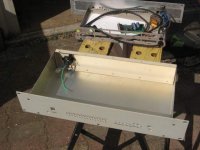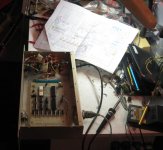1944GPW
Veteran Member
Well this is my first rather long-winded post here on what looks like a terrific forum.
Way back in 1978 my dad (an IBM engineer) thought that as kids, my brother and I would have a lot of fun and gain a better understanding of computers if we had our own. Very few kids had a 'home computer' in Australia back then, so naturally we were pretty excited. A work colleague of dad's who was a hardware guru had a working F8 system so we duly bought the same, known as the 'Mostek/Fairchild F8 Evaulation Kit / Design Kit'. It had 1k of RAM and 1k of ROM (containing the FAIRBUG monitor) and an unconventional CPU spread across three 40-pin DIPs.
When it arrived I guess my brother and I were expecting something that we could put a screen and keyboard on, and run BASIC, but what we got was a kit board and a bunch of chips. Dad had some junked IBM parts such as a 3277 EBCDIC keyboard, a Selectric I/O Writer (with the solenoids under the unit) and some 8" floppy drives. That was going to be our I/O and storage. Dad's hardware guru friend had designed and built the Selectric interface, as well as the converter for an IBM 8" floppy drive to a microcomputer, so we were going to build the same.
After soldering the board together we made a box and +5v/+12v power supply, but that was as far as we got. We spent some time learning F8 assembly and Dad wrote a program and designed a circuit to map EBCDIC to ASCII, and contemplating wire-wrapping a 4K or 8K memory expansion board using 2102's.
Time passed and not much later the F8 was put aside in favour of a lot more capable Applied Technology S-100 system kit with ASCII keyboard and a REAL VDU SCREEN!
Dad was a little disappointed that we never finished the F8 but we made up for it spending a lot of time playing about and learning on that machine and all the following ones but that's another story. So in the end, we never actually got to the stage of even powering up the F8.
Fast forward 30+ years and a few moves, and I thought that I'd have a go at trying to get the F8 to work, not just for my sake but in memory of my Dad who was always keen to help and support us learning about technology. Sadly the Selectric I/O typewriter, 3270 keyboard, floppy drives and other parts have been lost over the decades, all I have left is the original cardboard carton the F8 arrived in.
So... I unpack the dusty box and check that everything's still there. Assembled board and edge connector, check. F8 Data and Programming Guide books, check. Some advertising, check. Microcomputer-to-Selectric I/O interface circuit diagram (all 8 pages!) check. Some EBCDIC mapping code, check. Tiny BASIC article from Dr Dobbs, check. You can see this in the attached photos.
But.. the F8 Evaluation Kit board assembly diagram with the edge connector pinouts... missing! And I think there was a booklet on using FAIRBUG that's gone too. (I found another posting here on exactly the same board as I have but the poster isn't active, see http://www.vintage-computer.com/vcforum/showthread.php?16755-Fairchild-F-8-SBC)
It's probably a longshot but if anyone has the board edge connector pinout and FAIRBUG command guide I would be extremely grateful!
Steve.
Way back in 1978 my dad (an IBM engineer) thought that as kids, my brother and I would have a lot of fun and gain a better understanding of computers if we had our own. Very few kids had a 'home computer' in Australia back then, so naturally we were pretty excited. A work colleague of dad's who was a hardware guru had a working F8 system so we duly bought the same, known as the 'Mostek/Fairchild F8 Evaulation Kit / Design Kit'. It had 1k of RAM and 1k of ROM (containing the FAIRBUG monitor) and an unconventional CPU spread across three 40-pin DIPs.
When it arrived I guess my brother and I were expecting something that we could put a screen and keyboard on, and run BASIC, but what we got was a kit board and a bunch of chips. Dad had some junked IBM parts such as a 3277 EBCDIC keyboard, a Selectric I/O Writer (with the solenoids under the unit) and some 8" floppy drives. That was going to be our I/O and storage. Dad's hardware guru friend had designed and built the Selectric interface, as well as the converter for an IBM 8" floppy drive to a microcomputer, so we were going to build the same.
After soldering the board together we made a box and +5v/+12v power supply, but that was as far as we got. We spent some time learning F8 assembly and Dad wrote a program and designed a circuit to map EBCDIC to ASCII, and contemplating wire-wrapping a 4K or 8K memory expansion board using 2102's.
Time passed and not much later the F8 was put aside in favour of a lot more capable Applied Technology S-100 system kit with ASCII keyboard and a REAL VDU SCREEN!
Dad was a little disappointed that we never finished the F8 but we made up for it spending a lot of time playing about and learning on that machine and all the following ones but that's another story. So in the end, we never actually got to the stage of even powering up the F8.
Fast forward 30+ years and a few moves, and I thought that I'd have a go at trying to get the F8 to work, not just for my sake but in memory of my Dad who was always keen to help and support us learning about technology. Sadly the Selectric I/O typewriter, 3270 keyboard, floppy drives and other parts have been lost over the decades, all I have left is the original cardboard carton the F8 arrived in.
So... I unpack the dusty box and check that everything's still there. Assembled board and edge connector, check. F8 Data and Programming Guide books, check. Some advertising, check. Microcomputer-to-Selectric I/O interface circuit diagram (all 8 pages!) check. Some EBCDIC mapping code, check. Tiny BASIC article from Dr Dobbs, check. You can see this in the attached photos.
But.. the F8 Evaluation Kit board assembly diagram with the edge connector pinouts... missing! And I think there was a booklet on using FAIRBUG that's gone too. (I found another posting here on exactly the same board as I have but the poster isn't active, see http://www.vintage-computer.com/vcforum/showthread.php?16755-Fairchild-F-8-SBC)
It's probably a longshot but if anyone has the board edge connector pinout and FAIRBUG command guide I would be extremely grateful!
Steve.
Attachments
Last edited:





